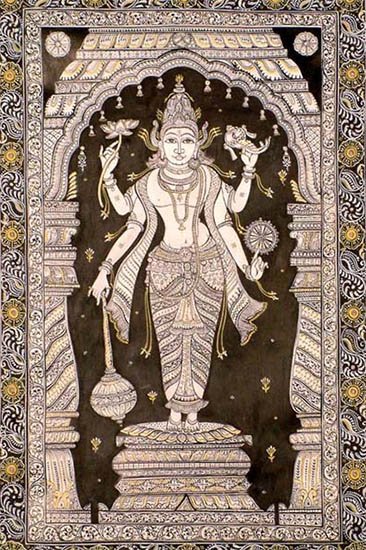Kamapala, Kāmapāla, Kama-pala: 13 definitions
Introduction:
Kamapala means something in Hinduism, Sanskrit, Jainism, Prakrit, Buddhism, Pali. If you want to know the exact meaning, history, etymology or English translation of this term then check out the descriptions on this page. Add your comment or reference to a book if you want to contribute to this summary article.
In Hinduism
Purana and Itihasa (epic history)
Source: archive.org: Puranic EncyclopediaKāmapāla (कामपाल).—A Yādava dependant of Śri kṛṣṇa. (Bhāgavata, 10th Skandha).
Source: Cologne Digital Sanskrit Dictionaries: The Purana IndexKāmapāla (कामपाल).—Joined Yadus in defeating Pauṇḍraka.*
- * Bhāgavata-purāṇa X. 66. [2].

The Purana (पुराण, purāṇas) refers to Sanskrit literature preserving ancient India’s vast cultural history, including historical legends, religious ceremonies, various arts and sciences. The eighteen mahapuranas total over 400,000 shlokas (metrical couplets) and date to at least several centuries BCE.
Shilpashastra (iconography)
Source: Wisdom Library: Śilpa-śāstraKāmapāla (कामपाल) is a Sanskrit name referring to one of the eight manifestations of Caṇḍa, who is a form of Bhairava. According to the Rudrayāmala, there are eight main forms of Bhairava who control the eight directions of this universe. Each form (e.g., Caṇḍa) has a further eight sub-manifestations (e.g., Kāmapāla), thus resulting in a total of 64 Bhairavas.
When depicting Kāmapāla according to traditional iconographic rules (śilpaśāstra), one should depcit him (and other forms of Caṇḍa) having a blue color and good looks; he should carry agni, śakti, gadā and kuṇḍa. The word Śilpaśāstra refers to an ancient Hindu science of arts and crafts, dealing with subjects such as painting, sculpture and iconography.

Shilpashastra (शिल्पशास्त्र, śilpaśāstra) represents the ancient Indian science (shastra) of creative arts (shilpa) such as sculpture, iconography and painting. Closely related to Vastushastra (architecture), they often share the same literature.
In Jainism
General definition (in Jainism)
Source: archive.org: TrisastisalakapurusacaritraKāmapāla (कामपाल) is an incarnation of the merchant Dhanada, according to chapter 5.4 [śāntinātha-caritra] of Hemacandra’s 11th century Triṣaṣṭiśalākāpuruṣacaritra: an ancient Sanskrit epic poem narrating the history and legends of sixty-three illustrious persons in Jainism.
Accordingly, as Śānti-nātha narrated to king Kurucandra:—“In this very Jambūdvīpa in this same zone Bhārata in the country Kosala in the city Śrīpura there were four merchants’ sons of the same age, like full brothers, Sudhana, Dhanapati, Dhanada, Dhaneśvara. [...] Sudhana and Dhanada both died and became merchants’ sons, the former in Kāmpīlya and the latter in Kṛttikāpura. Vasantadeva was the name of the first and Kāmapāla of the second. [...]”.

Jainism is an Indian religion of Dharma whose doctrine revolves around harmlessness (ahimsa) towards every living being. The two major branches (Digambara and Svetambara) of Jainism stimulate self-control (or, shramana, ‘self-reliance’) and spiritual development through a path of peace for the soul to progess to the ultimate goal.
Languages of India and abroad
Sanskrit dictionary
Source: DDSA: The practical Sanskrit-English dictionaryKāmapāla (कामपाल).—Name of Balarāma; also of Śiva.
Derivable forms: kāmapālaḥ (कामपालः).
Kāmapāla is a Sanskrit compound consisting of the terms kāma and pāla (पाल).
Source: Cologne Digital Sanskrit Dictionaries: Shabda-Sagara Sanskrit-English DictionaryKāmapāla (कामपाल).—m.
(-laḥ) A name of Balarama, the brother of Krishna. E. kāma Kama, and pāla who cherishes; being by one legend the paternal uncle of that deity.
Source: Cologne Digital Sanskrit Dictionaries: Cappeller Sanskrit-English DictionaryKāmapāla (कामपाल).—[masculine] [Epithet] of Śiva (*& Baladeva).*
Source: Cologne Digital Sanskrit Dictionaries: Monier-Williams Sanskrit-English Dictionary1) Kāmapāla (कामपाल):—[=kāma-pāla] [from kāma] m. ‘gratifier of human desires’, Name of Viṣṇu, [Viṣṇu-smṛti, viṣṇu-sūtra, vaiṣṇava-dharma-śāstra]
2) [v.s. ...] of Śiva, [cf. Lexicographers, esp. such as amarasiṃha, halāyudha, hemacandra, etc.]
3) [v.s. ...] of Baladeva, [cf. Lexicographers, esp. such as amarasiṃha, halāyudha, hemacandra, etc.]
4) [v.s. ...] of a man, [Daśakumāra-carita]
Source: Cologne Digital Sanskrit Dictionaries: Yates Sanskrit-English DictionaryKāmapāla (कामपाल):—[kāma-pāla] (laḥ) 1. m. Balarāma.
[Sanskrit to German]
Sanskrit, also spelled संस्कृतम् (saṃskṛtam), is an ancient language of India commonly seen as the grandmother of the Indo-European language family (even English!). Closely allied with Prakrit and Pali, Sanskrit is more exhaustive in both grammar and terms and has the most extensive collection of literature in the world, greatly surpassing its sister-languages Greek and Latin.
Pali-English dictionary
Source: Sutta: The Pali Text Society's Pali-English DictionaryKāmapāla refers to: the guardian of wishes, i.e. benefactor J. V, 221;
Note: kāmapāla is a Pali compound consisting of the words kāma and pāla.

Pali is the language of the Tipiṭaka, which is the sacred canon of Theravāda Buddhism and contains much of the Buddha’s speech. Closeley related to Sanskrit, both languages are used interchangeably between religions.
Kannada-English dictionary
Source: Alar: Kannada-English corpusKāmapāla (ಕಾಮಪಾಲ):—[adjective] fulfilling a desire or desires; satisfying (another’s) wish or wishes.
--- OR ---
Kāmapāla (ಕಾಮಪಾಲ):—
1) [noun] Balarāma, the elder brother of Křṣṇa.
2) [noun] Viṣṇu.
3) [noun] Śiva.
--- OR ---
Kāmapāḷa (ಕಾಮಪಾಳ):—[noun] = ಕಾಮಪಾಲ [kamapala]2.
Kannada is a Dravidian language (as opposed to the Indo-European language family) mainly spoken in the southwestern region of India.
See also (Relevant definitions)
Partial matches: Kama, Paala, Pala.
Starts with: Kamapalaka, Kamapalamantra, Kamapalan.
Full-text: Kamapalaka, Somadevi, Kamapalamantra, Somadeva, Canda, Vasantadeva, Kama.
Relevant text
Search found 11 books and stories containing Kamapala, Kāmapāla, Kama-pala, Kāma-pāla, Kāmapāḷa; (plurals include: Kamapalas, Kāmapālas, palas, pālas, Kāmapāḷas). You can also click to the full overview containing English textual excerpts. Below are direct links for the most relevant articles:
Sahitya-kaumudi by Baladeva Vidyabhushana (by Gaurapada Dāsa)
Text 4.50 < [Chapter 4 - First-rate Poetry]
Garga Samhita (English) (by Danavir Goswami)
Verse 8.11.3 < [Chapter 11 - The King of Prayers to Lord Balarāma]
Verse 8.13.5 < [Chapter 13 - A Thousand Names of Lord Balarāma]
Verse 1.10.36 < [Chapter 10 - Description of the Birth of Lord Balarāma]
Trishashti Shalaka Purusha Caritra (by Helen M. Johnson)
Part 14: Story of Kurucandra < [Chapter V - Twelfth incarnation as Śānti]
Dandin's Method of Narration < [October - December 1975]
The Padma Purana (by N.A. Deshpande)
Chapter 87 - A Hundred Names of Viṣṇu < [Section 2 - Bhūmi-khaṇḍa (section on the earth)]
The Nilamata Purana (by Dr. Ved Kumari)